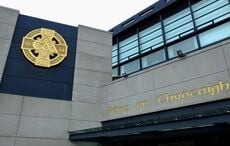The signatures of the great-great grandfather and great-uncle of former US President Ronald Reagan have been discovered on one of Ireland's most historic documents.
The Morpeth Roll was created in 1841 to mark the occasion of Lord Morpeth's departure from his political office in Ireland. He was a very popular administrator.
The lengthy pre-Famine document was signed by approximately 160,000 people on 652 individual sheets of paper, which were subsequently joined together to create a continuous length of paper, 1,350 feet long.
But for many years the testimonial remained hidden away in a forgotten basement at remote Castle Howard in North Yorkshire in England – the family home of Lord Morpeth.
However, following the document's discovery three years ago, experts from NUI Maynooth have conducted extensive research on the 'thank-you scroll,' which is one of the few primary resources from the 1840s.
One of the most exciting discoveries unearthed were the signatures of Reagan's ancestors, who were both called Thomas Reagan and who hailed from Ballyporeen, Co. Tipperary.
Curator Paul Hoary confessed to “leaping all over the place” when he found it.
Reagan's great-grandfather and Thomas Reagan's son, Michael Reagan, emigrated to the United States via England. President Reagan's grandfather, John Michael Reagan, was born in Illinois.
The detailed study also uncovered the signatures of Arthur Guinness' son, Arthur Jr, and several signatures from the Irish brewing families Beamish and Smithwick.
The Irish Times also reports that Patrick Feeney, the grandfather of celebrated film director John Ford – who made the classic movie, "The Quiet Man" – also signed his name in English, even though he lived in an Irish-speaking area.
One noteworthy feature of the scroll is that few names were signed in Irish, despite it being the language of the bulk of the population at the time.
The roll – described as the 'longest thank you in Irish history' – has been touring Ireland and is currently on display in the John Paul II library in NUI Maynooth.
All the signatures on it have been digitised and are available to view online at www.ancestry.com.
The signatures were gathered in 1841 – only a few years prior to the Great Famine – when relations between Ireland and Britain were relatively good.
Lord Morpeth, who was chief secretary from 1835 to 1841, was regarded as a popular figure and a reforming politician – reflected in other signatories from key Irish historical figures, including Daniel O'Connell, Thomas Gavin and Charles Gava.
Speaking at the launch of a book yesterday entitled 'The Morpeth Roll: Ireland identified in 1841,' NUI Maynooth President Philip Nolan drew parallels with the upcoming state visit by Ireland President Michael D Higgins to Britain.
Professor Nolan said the roll showed that the history between Ireland and Britain was “much more complex than the history that we might have been taught in school. We were never told there was also a view of British rule which saw aspects of it and individuals involved in it as constructive and benign. It is something worth reflecting on as we re-evaluate the relationship between the two islands.”




Comments